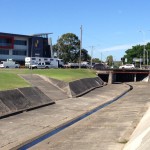 Back in 2014 a change of residence meant that my bicycle commute to work changed to a route that took me alongside long stretches of the concrete drains that spider across the low lying Newcastle suburbs. For 85% of my commute to work I am within 200 metres of one of the concrete drains, or Throsby Creek.
Back in 2014 a change of residence meant that my bicycle commute to work changed to a route that took me alongside long stretches of the concrete drains that spider across the low lying Newcastle suburbs. For 85% of my commute to work I am within 200 metres of one of the concrete drains, or Throsby Creek.
In a recent conversation with a friend when I mentioned this, they responded with some expression of sympathy and sadness that I had to endure such an ugly travelling companion. As I reflected on this  reaction I realised that although the drains are not exactly the most aesthetic feature of our city, there are a number of positives.Firstly, cycling alongside the drains offers relative serenity, in comparison to busy roads. Secondly, the drains often attract a variety of bird life – ducks, ibises, some other kinds of birds, the black and white ones, the fast darting ones, as well as those little fluttery ones. (As much as I like birds, you might correctly guess I’m no ornithologist!)
reaction I realised that although the drains are not exactly the most aesthetic feature of our city, there are a number of positives.Firstly, cycling alongside the drains offers relative serenity, in comparison to busy roads. Secondly, the drains often attract a variety of bird life – ducks, ibises, some other kinds of birds, the black and white ones, the fast darting ones, as well as those little fluttery ones. (As much as I like birds, you might correctly guess I’m no ornithologist!)
In thinking about the concrete drains I’ve also been pondering their principal purpose – to drain away water. In the downpours of January 2016 I saw this fully in action, and recorded this video of the drain in Broadmeadow near the rescue helicopter base.

It got me thinking. How much water was being carried away each second? Stepping through the frames on the video I was able to see that it took 2.94 seconds for the flow to pass from one concrete seam in the drain to the next. A visit to the drain a few weeks later (when it was dry) to take some measurements revealed the following.
| Distance between cracks: | 9.1m |
| Average width of drain: | 13.4m |
| Average depth of drain: | 1.6m |
| Cross sectional area: | 21.44m2 |
| Water velocity: | 3.1 m/s |
| Flow volume (cubic metres per sec): | 66.4 m3/s |
That’s 66 thousand litres per second. Impressive. Or to put it another way, since a standard size Olympic swimming pool contains 2.5 million litres, the waterway at this point is capable of draining an Olympic sized swimming pool every 38 seconds.
[ Note that all these measurements and calculations are ‘back of the envelope’, ‘ballpark figures’ for the purpose of gaining a broad sense of the capabilities of the drain, and not a precise hydrological survey. ]
I’ve also been pondering the economic benefit of these drains. Prior to their construction from 1895 onwards, the lowlands of Newcastle were regularly turned into a useless boggy swampland. A 1892 description of Broadmeadow states that:
“When there are heavy rains the water comes down in such a way as to flood the streets and property, the water being sometimes 12 and 18 inches deep on the streets.”
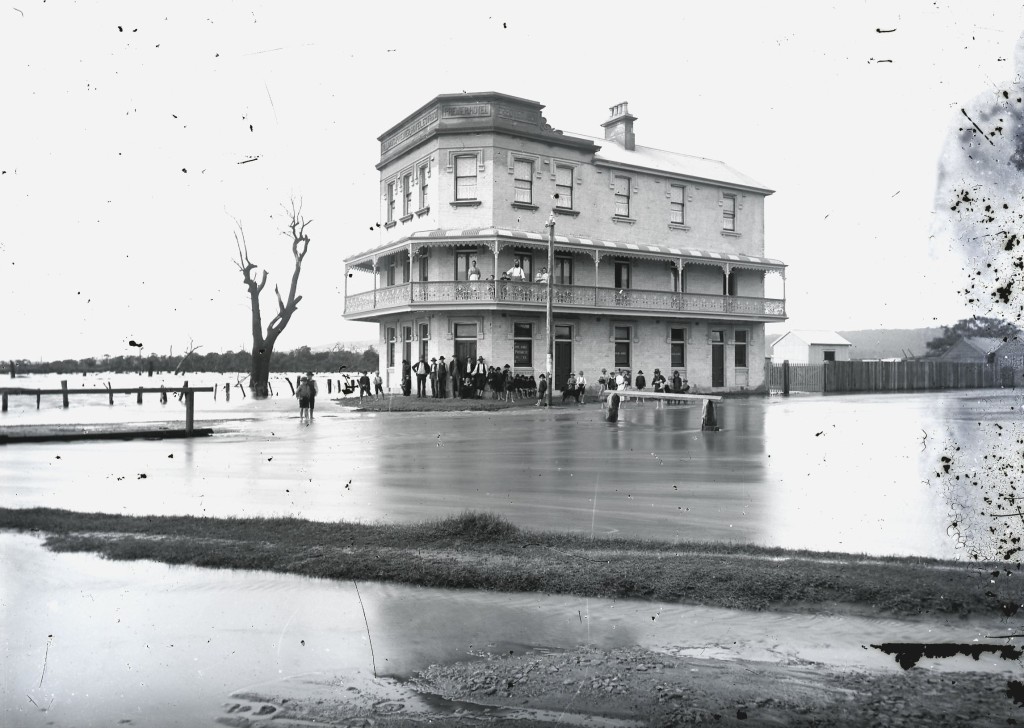
Premier Hotel in Broadmeadow surrounded by flood waters in 1892. Photo by Ralph Snowball. University of Newcastle Cultural Collections.
The 1897 Ralph Snowball photograph below looking from Glebe Rd Merewether across to Hamilton graphically illustrates the large plain of unused and unusable land, and with the roads suffering significant water erosion.
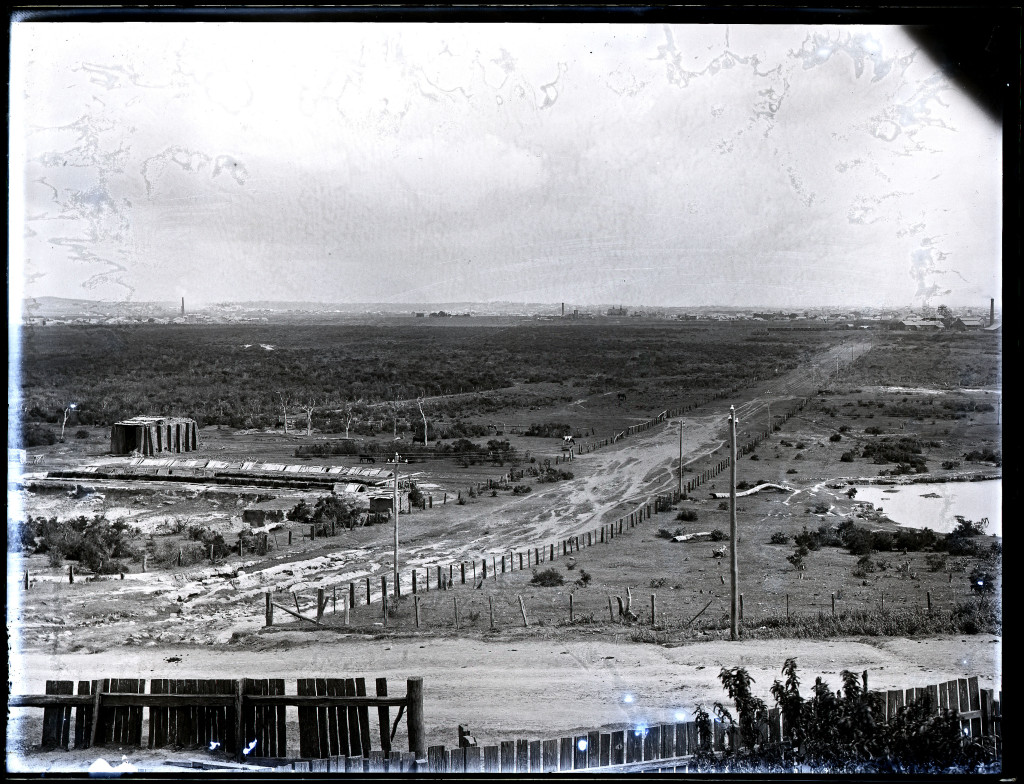
The Newcastle lowlands, 1897. Photo taken from intersection of Beaumont St and Glebe Rd looking north towards Hamilton. University of Newcastle Cultural Collections.
Even as construction was progressing the economic benefit of drainage was clear to see, with an 1897 newspaper report on the extension of the system into Adamstown noting that:
“Its construction will prove a great boon to those residing on the lowlands, and should increase the value of property materially.”

Drain construction workers at Broadmeadow, NSW, 6 April 1900. University of Newcastle Cultural Collections.
The question then is what is the area of the “lowlands” that are emptied by the drainage system? Browsing the altitude data in Google Earth, and observing the landscape around town, 15 metres above sea level seems to be the inflection point where a gradual rise in elevation across the plains changes to a steeper inclinaton of the surrounding hills and ridges. Using Google Earth I marked with yellow lines the concrete drains, and mapped out in blue the area of the drainage basin that is 15m or less above sea level. This area totalled approximately 1850 hectares. [ KML file viewable in Google Earth ]
[ Note, as before, this mapping is a rough approximation for the purpose of gaining a broad sense of the capabilities of the drainage system, and not a precise hydrological survey. ]
As an aside, when I first viewed the map of the drains against the shaded lowlands, it immediately struck me that there is a large area centred on Hamilton that has no open concrete drains, and my recollection is that in the June 2007 Pasha Bulker storm, Hamilton was one of the main areas of flooding. Coincidence or not? I don’t know, as I keep reminding you, I’m not a hydrologist.
Nor am I an economist. With that final disclaimer out of the way I can now ask, how much is all that land worth? What is the monetary value of the land made productive by the open concrete drain system? As an example of land values, the NSW Valuer General shows that in 2015 a 424 m2 area of land in Hamilton North had a value of $327,000. This equates to $771 per square meter, or $7.7 million per hectare. If we assume that only 75% of the 1850 hectares is usable (allowing for roads, creeks, etc) then the total land value of the lowlands shaded in the map above is … 10.7 billion dollars!
So the next time you pass one of those ‘ugly’ concrete drains … give a bit of respect.
For more drain related musings, check out Mark Maclean’s Hamilton North blog.

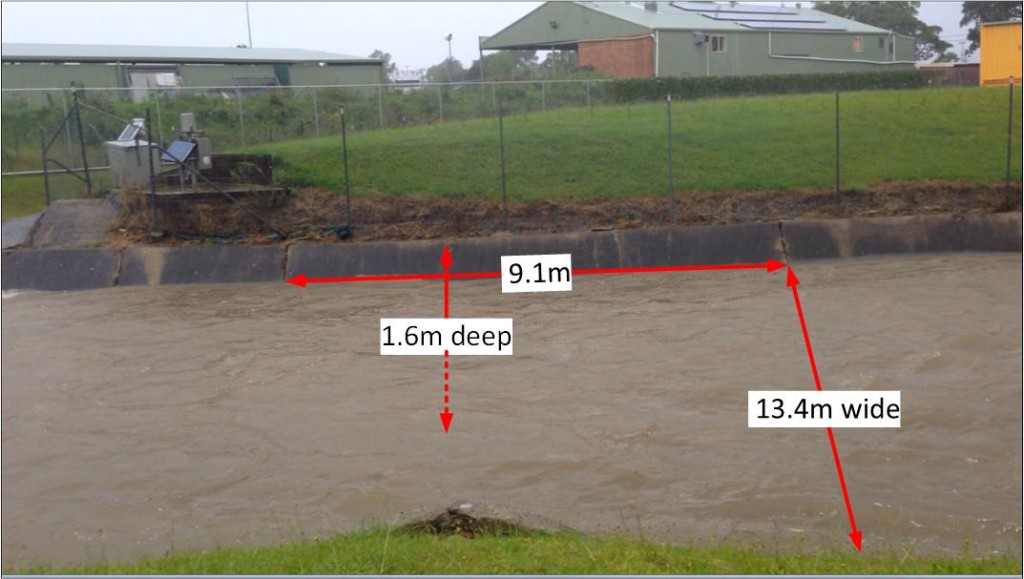
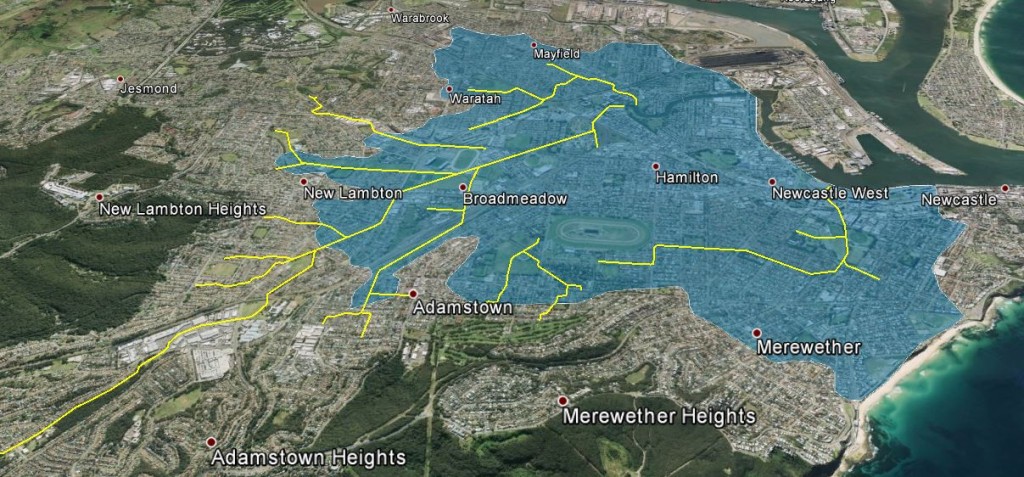
Pingback: The Tale of the Beach Hotel - The Beach Hotel
G’day Lachlan,
It wasn’t until I started doing some research on the Australasia Coal Co. and it’s old railway to nowhere in Kotara / Hillsborough, that I realised that the old railway route was turned into the Broadmeadow drain. Looking at your photo above I can see that the route of the Gully line has similarly been turned into a drain. I guess once these ” rights of way” have been declared by Parliament, they are then a clearway where council can do anything with the land once it is no longer needed by the mines, and that this would make an ideal drain – flat, straight-ish etc.
> I can see that the route of the Gully line has similarly been turned into a drain.
Not quite. The stormwater channel ran alongside the Gully Line railway. The drain corridor was gazetted in 1895, and the Raspbery Gully colliery did not close until 1961, so there were quite a few years where the railway and drain co-existed. In Jim Longworth and Grant Fleming’s book “Tracing Tracks Through Newcastle” on page 145, they have a photo of a train running on the line alongside the drain.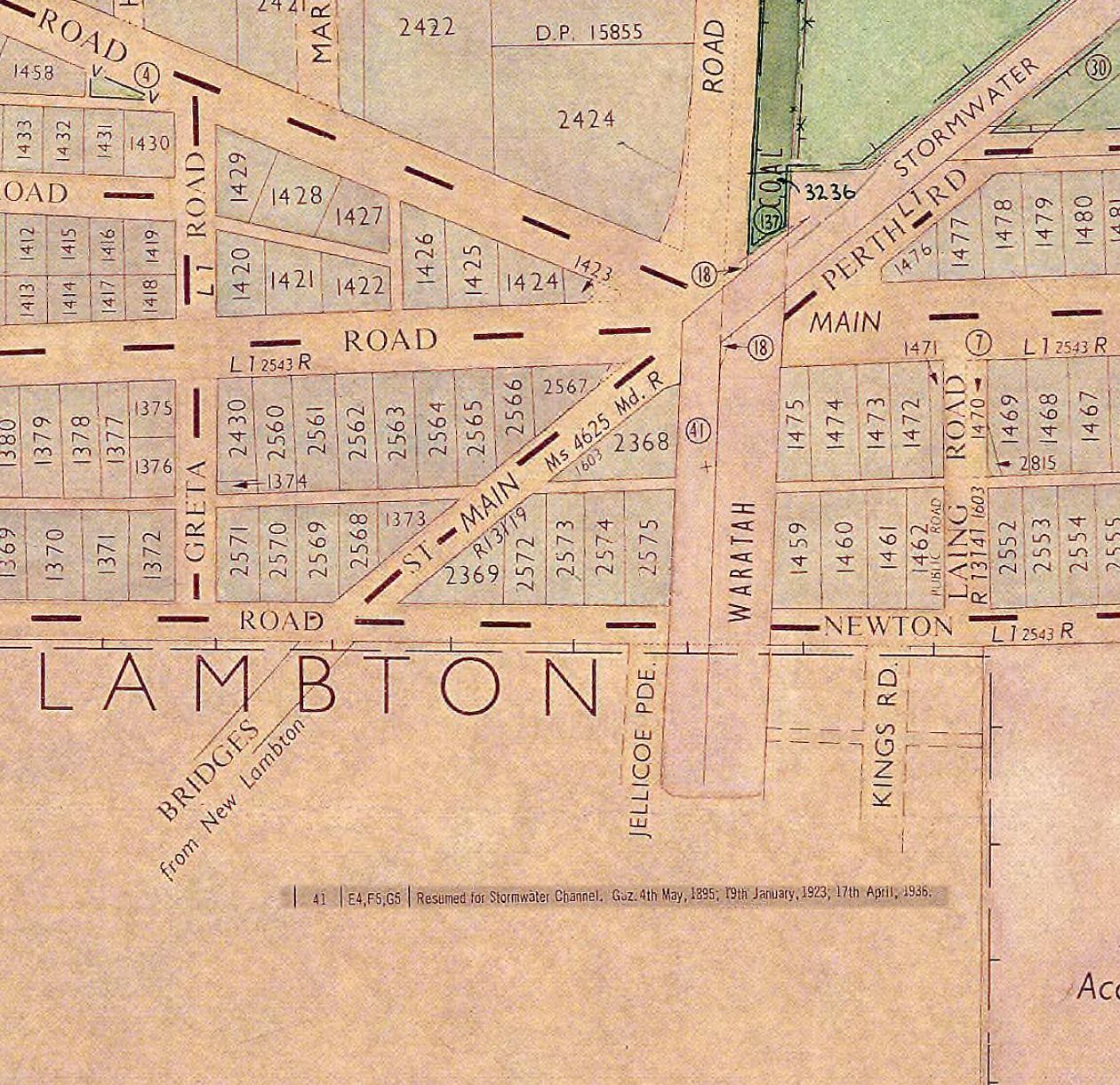
> I guess once these ” rights of way” have been declared by Parliament, they are then a clearway …
Once the original need of a railway has passed, the corridor gets used by various levels of government and/or private enterprise, for various uses. In my research I’ve seen former railway corridors get repurposed for drains, roads, parks, cycle ways, and housing. I find it fascinating how the outline of former railway paths persist in the urban landscape years after the railway has gone, such as the housing in the Gully Line corridor in New Lambton below.
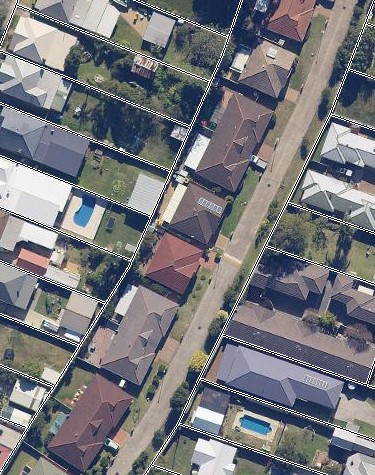
Dear Lachlan, you are a very good local historian. I grew up in the old Merewether, from 1964, in Ridge Street. Loved some of your photos from around the area, esp. the one aiming North looking down into Hamilton from cnr Beaumont St and Glebe Rd. My father’s family moved into Ridge Street in 1937, my paternal grandparents were Irish and arrived in the previous decade. People looked down on those who lived in Merewether in the 1950’s, it was a quaint sea village when I grew up there, just up from the Beach Hotel, but all of that has sure changed now. The tram to Merewether Beach stopped in 1951, but there are old photos of it from the very early 20th century opposite the Beach Hotel. In the 1970’s not everyone had cars in Merewether or the phone on and if they had a car, it was one car per family. We caught the 207 bus into town, which I still remember from half a century ago, when it was really busy in there and the shopping centres weren’t yet taking people away from town, but it was the end of an era, it had changed markedly by the end of the 1970’s and more so into the 1980’s. Love your work and hoping your family are all well. God bless, John.
Pingback: Then drain, again drain | A bit of this, a bit of that